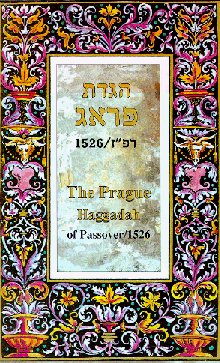| The Prague Haggadah | ||||||
|
This double nature is reflected in its literary construction, its illustrations, additions, songs and commentaries . Our ancestors became slaves in Egypt: G-d brought us out of this slavery, through many miracles, to be free to settle in the Holy Land . The Haggadah explains that without the miracle of this great deliverance, we , the descendants, would still be slaves in Egypt. The Passover Haggadah is therefore a drama, which is reenacted annually on Passsover Eve. Part of the text presents the ritual, while other parts include prescriptions for the actions and the reasons for them. Artists who illustrated the Passover Haggadah through the ages, depicted the slavery and the Exodus from Egypt, and added illustrations of the visions of the redemption , with creative and artistic impulse.
The lively illustrations expressed the sentiments of freedom and joy felt by every Jew on the Passover Festival .
The first printed Hebrew book, after the invention of printing, came off the press in 1475, and only a few years later, about 1482, the Passover Haggadah was printed in Spain . The Prague Haggadah was the first Passover Haggadah book to be printed in Central Europe after the Jews were expelled from Spain ( 1492 ). As the first printed illustrated Haggadah book in Central Europe it was used as prototype for many illustrated editions of the Passover Haggadah printed afterwards in Europe. The Prague Haggadah is the first illustrated Haggadah to be preserved in its entirety, and till nowadays it is considered as one of the most beautiful editions of the Passover Haggadah books Although not the first illustrated Haggadah, it is no doubt the first to have been executed with a care for aesthetic taste and feeling, apparent not only in the attractive woodcuts but also in the fine lettering, splendid initials and the general layout. The printer's name, published on the end of the volume, is Gershom Cohen, who reports that with the help of his brother Gronem Katz , finished the Prague Haggadah on the last day of the year 1526 The artist , or craftsman, who made the woodcuts was apparently a man named Hayyim Shachor or Schwartz (the letter "sh" is found in four of the woodcuts). However, some of the woodcuts may have been made by other artists . The Prague Haggadah presents a new tendency in the artistic tradition of illuminated Haggadah books, due to the replacement of ancient methods with the new methods of printing woodcuts. Using the advantages of the new craft of printing it is handsome in the profuse decorations which form the borders of its main pages, the ornamental initials, the imaginative decorations which are all printed woodcuts. There are four groups of woodcuts: the decorative words, the full page borders, the wide scenes, the marginal figures. However, the artist economized on the number of woodcuts by reusing quiet a number of them more than once. Traditional Jewish subjects, motifs and iconography were fused with the more fashionable styles and layouts of contemporary religious illuminations and regional views, according to the personal taste of the artist .
Printers in different Jewish centers began to produce Haggadah books of their own and drew on the Prague Haggadah in style. The Prague Haggadah of 1526 set the tone for many future printed Haggadah books . It was described by one authority as "among the finest productions of the 16th century printing press in any language" . This special new edition of the Gershom Cohen's Prague Haggadah, is presented here at the first time, fully coloured and lavishly displayed, to bring esthetic and spiritual enrichment to nowadays Seder table. |
||||||
|
|
||||||





 The text and illustrations had also a practical purpose: to provoke questions from the children and thus give the father an opportunity fully to relate the story of the Exodus
The text and illustrations had also a practical purpose: to provoke questions from the children and thus give the father an opportunity fully to relate the story of the Exodus 





 0
0